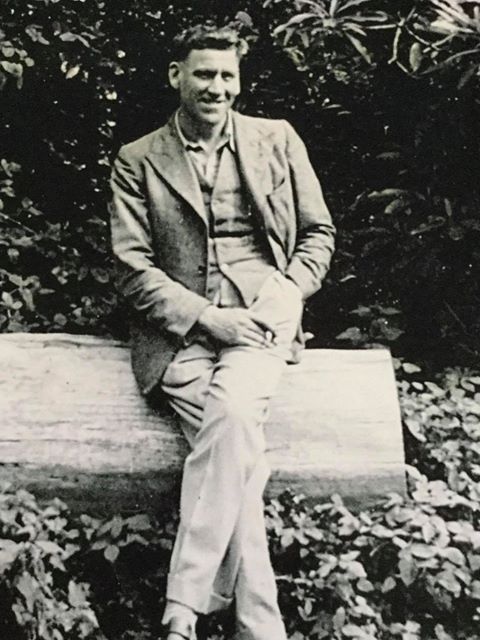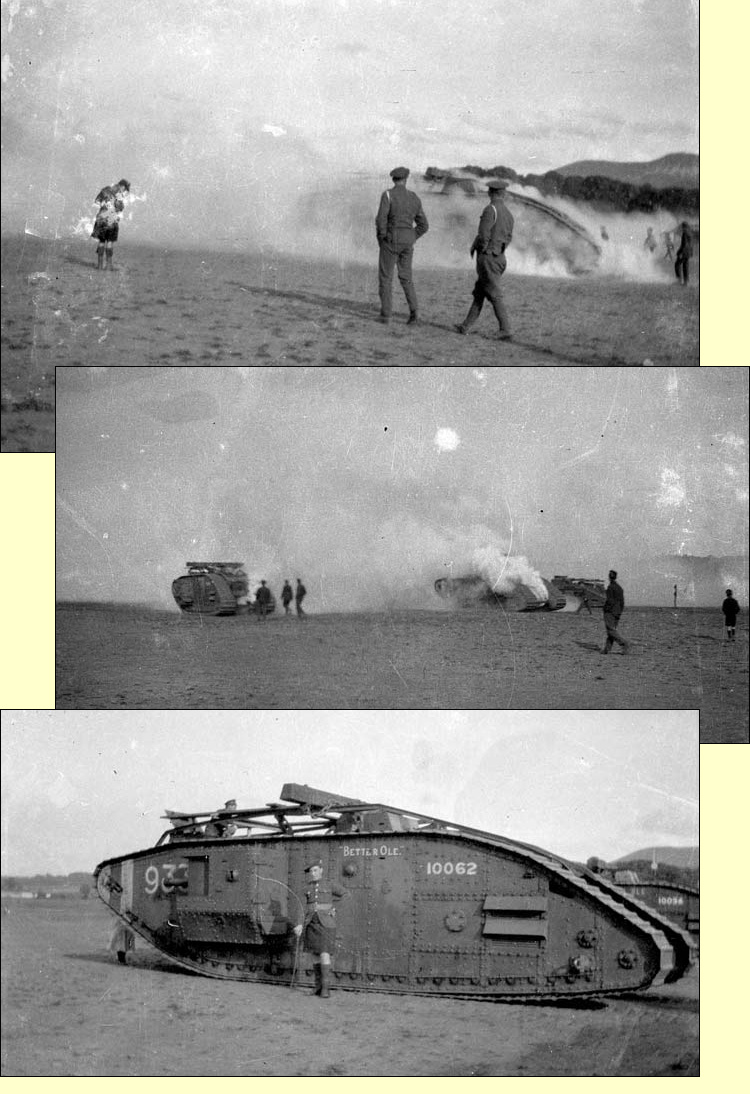This is a page within the www.staffshomeguard.co.uk website. To see full contents, go to SITE MAP.
MEMORIES and INFORMATION: 32nd Battn. (20)
32nd Staffordshire (Aldridge) Battalion
Home Guard
THE FODEN and
CUTLER FAMILIES
(STREETLY
and LITTLE ASTON)
|
During WW2,
members of the
Foden and
Cutler families in
Streetly
and
Little Aston - in particular
Arthur Edgar Foden
and
Linnaeus William Cutler - made significant
contributions in their own ways to the local Home
Guard, in the form of
"B" Company, 32nd Staffordshire
(Aldridge) Battalion. They are part of its history.
And they had something else in common which 21st
century genealogical research has uncovered: a close
family connection. The two men were second cousins
and, even in those days when family history studies
were far from easy and rarely performed, they were
almost certainly aware of that fact.
This page
commemorates both men, explains some of their
contribution to Home Guard affairs and provides
information about the family groups to which they
belonged.
A brief note
about the Foden family appears in the 1945 record of
the local Battalion, written by
Lt.-Col. Charles
Cartwright, M.C.
|
......For various reasons
outside anybody's control, the Spigot Mortar teams
became dispersed to some extent, and to look after the
training of fresh teams and to carry on the training
of existing ones the C.O. gave permission for a
Battalion Spigot Mortar School
to be opened at
Foden's Farm,
Mill Green, Chester Road.
Second Lieut.
(now Lieut.) G. C. Richards
was put in charge and in a short time we had
a self-contained instructional unit complete
with lecture room, stores, inert firing
range with static and moving targets. This
was due to Richards's keenness and to the
ready assistance given by the Foden family.
They had been our good friends since the
"early days" and it was with genuine sorrow
and regret that we learnt of Mr. Foden's
tragic death while working on the land he
had farmed all his life. His sons, three of
whom were members of the Home Guard, will
carry on the farm, but their father will be
missed for many a day and his and Mrs.
Foden's kindnesses will long be remembered
among the Home Guards based on Foden's
Farm....... |
Mr. Foden's
full name was
Arthur Edgar Foden. He was a member of
an extended family with its origins in the inner city
areas of Birmingham in the 18th and 19th centuries.
The family's area of influence seems to have extended,
during the nineteenth century and later, to the north
of the city and into Staffordshire. Many of its
members were farmers and licensed victuallers and were
either tenants or owners of the various properties in
which they lived. A remarkable number of farms and
public houses in the area are associated with their
name, at one time or another. And the family assumed
other business interests too: for example, in
Streetly, there was a Foden motor business in
Burnett
Road in the 1920s and, perhaps a little later, a Foden
horticultural business under the name of
Hardwick
Nurseries.
Arthur Foden
(1886-1944)
lived at, ran and almost certainly owned
Mill Green
Farm, located on
the Chester Road between the
Irish Harp and
the
Plough & Harrow pubs. His wife, whom Col.
Cartwright also praised, was
Nellie
(née Downes,
1888-1967). They had a number of children: a daughter,
Frances and four sons:
William, Edgar, George and
Thomas; and it seems as though three of these boys
were members of the local Home Guard. They would
almost certainly have been members of what was
originally called
No. 1 Platoon (probably later renamed
as
No.5 Platoon, which in turn was part of
the Battalion's
"B" Company. Conveniently No.1 Platoon
was based at
Mill Green
 Farm as is confirmed by
an early map
on another page of this website: this denotes the Company's area of
responsibility (but does not mention the Artillery
Range, which had not been established at that time). Farm as is confirmed by
an early map
on another page of this website: this denotes the Company's area of
responsibility (but does not mention the Artillery
Range, which had not been established at that time).
Arthur himself does not appear to have
been a member of his boys' unit but made a significant
contribution to the local Home Guard effort by hosting
and supporting a mortar school and firing range at his
farm.
No evidence now remains about the school
and range, apart from Col. Cartwright's appreciative
note above; and also a humorous reference to its
existence in a jokey 1945 map drawn by the Battalion
Adjutant,
Capt. Frank Timings
(right).
Arthur's
passing must have been an unspeakable tragedy, not
only for his and the wider local family but also for
the neighbourhood as a whole. A newspaper report on
the findings of the inquest:

(The Lichfield
Mercury, October 1944)

Linnaeus William "Bill" Cutler
(left) founded
and owned
Cutler's Garage, on the
Chester Road
in
Streetly, next door to the
Hardwick Arms public house,
and he lived nearby, in
Wood Lane. He too made a
significant contribution to the local Home Guard, in
several different ways.
Bill Cutler was
Company Sergeant Major (of "B" Company which covered
Streetly and Little Aston - an appointment which must
have relied on his previous Great War service and
would have weighed heavily on his time and energy). He
ensured his business was very supportive of the Home
Guard effort. A teen-aged bicycle messenger for the
Home Guard - too young to join as a full member -
recalled later, in
a memoir written for
staffshomeguard, helping to clear out the store of
Home Guard equipment held at Cutler's Garage after the
service had been disbanded.
.....And another
contribution:
|
THE 32nd
BATTALION ARMOURED VEHICLE |
There are hints that at
some stage during the war, Cutler's had plans to
create an armoured vehicle for Home Guard use. Images
survive of what appears to be preparatory work on this.
The Webmaster has a personal memory of one incident which almost
certainly related to it.
.... On a wintry Sunday morning,
when I was five or six, my father
took me to a field behind
Cutler's Garage
in Streetly. There he met up with some of his comrades
and a large sheet of thin steel.
I imagined at the time that the metal was to be used for some defensive
purpose, possibly the protection
 of a vehicle. The
sheet was propped up against a bush and all of us
except for my father retired to a safe distance. I
was told to cover my ears; my father raised his Webley
revolver,
took aim at the middle of the sheet and pulled the
trigger. (The target this time was of course a little
more difficult to miss than on the occasion when I
witnessed him leaning out of his
bedroom window, trying to pick off a
grazing rabbit on our neighbour's
lawn). We then gathered around it
and balefully examined the damage. The experiment
was deemed a success as the sheet, whilst severely
dented and gouged, had not been penetrated. It was then carried
off towards the garage and we all went our separate
ways. Thirty years later the script of "Dad's
Army" would have concluded this little episode
with Warden Hodges tearing across the field in our
direction, puce-faced under his ARP helmet, shaking
his fist and shouting "Ruddy 'ooligans!!"....... of a vehicle. The
sheet was propped up against a bush and all of us
except for my father retired to a safe distance. I
was told to cover my ears; my father raised his Webley
revolver,
took aim at the middle of the sheet and pulled the
trigger. (The target this time was of course a little
more difficult to miss than on the occasion when I
witnessed him leaning out of his
bedroom window, trying to pick off a
grazing rabbit on our neighbour's
lawn). We then gathered around it
and balefully examined the damage. The experiment
was deemed a success as the sheet, whilst severely
dented and gouged, had not been penetrated. It was then carried
off towards the garage and we all went our separate
ways. Thirty years later the script of "Dad's
Army" would have concluded this little episode
with Warden Hodges tearing across the field in our
direction, puce-faced under his ARP helmet, shaking
his fist and shouting "Ruddy 'ooligans!!"....... |
Much later some
images surfaced which seemed to confirm the
existence of this project and its initial
development - at least as far as a set of
drawings, (whose detail is regrettably
invisible in the first two of the following
images); and the creation of a usable
chassis, both in and behind Bill Cutler's
garage premises.

Unfortunately there is no further
reference to such a project, no more images,
no memory, no mention in the Battalion
record, and so one has to assume that it was
never carried through to fruition from these
early stages.
|
In early 2025, fascinating information surfaced
from an unexpected source which tells us much about
Bill Cutler's Great War experience and suggests to
us what lay behind his obvious enthusiasm and
initiative with regard to the creation of Streetly's
very own armoured vehicle: Bill was one of the
earliest men to serve in the British Army's wholly
new invention - an effective armoured vehicle given
the code word "tank". (That project had been
given the necessary impetus by the enthusiam of the
then First Lord of the Admiralty, Winston Churchill). This is a summary of
Bill's war record, generously provided to this
website by Stephen Pope, a member of the First Tank
Crews Research Group:
|
BILL
CUTLER'S GREAT WAR SERVICE |
In April
1916, Bill volunteered to join the Motor
Machine Gun Service, a formation which was
the predecessor of the
Tank Corps.
Bill joined for initial training at
Bisley
on 19th April 1916 and was immediately
accepted. This was undoubtedly due to his
previous employment as a motorcycle engine
fitter. Having trained as a machine gunner,
Bill initially served with "B" Company,
Heavy Section, Machine Gun Corps. He
deployed to France on 14th October and was
then
posted to "B" Battalion, Heavy Branch,
M.G.C. when it was formed the following
month. Bill trained as a tank driver in the
spring of 1917 and, on 27th July, was graded
a 1st Class Tank Mechanist.
Renumbered as 77546 Tank Corps, he almost
certainly fought at the
Battle of
Messines
in June 1917,
3rd Ypres
(July - August 1917) and at
Cambrai
(November 1917).
Appointed paid
Lance Corporal on 1st August 1918, Bill was
posted to the Tank Corps Reinforcement and
Training Depot at
Le Treport
between 8th and 19th August and, as a
result, did not take part in the
Battle of
Amiens. It
is likely that he completed a trade
upgrading course during his time or possibly
was assessed for suitability as a tank
driving and maintenance instructor. In
October, he was posted to the Tank Corps
Depot at
Wareham.
At this time, six new tank
battalions were being formed and cadres of
experienced officers and NCOs sent back to
provide key personnel for the new units.
Bill was posted to 20th Battalion, Tank
Corps as a substantive Lance Corporal on 3rd
November and appointed acting Sergeant three
days later. He served with the Battalion
after many of his contemporaries had been
demobilised, being promoted substantive
Sergeant on 31st March 1919. He was
demobilised on 29th August 1919.
We
Remember Him Still!
Stephen Pope
First Tank Crews Research Group
Author of "The First Tank Crews: The
Lives of the Tankmen who Fought at the
Battle of Flers Courcelette - 15th September
1916"
(N.B. This was the
first battle in which tanks were seen and
used, a few weeks before Bill Cutler arrived
in France). |
And thus we learn that Bill Cutler was one of
the earliest tank drivers in history, a pioneer of a
method of warfare which came to dominate the
battlefield and persists up to the present day. Even
the most cursory research into the lives of the men
involved at that time tells us of the immense risks
which they ran and the almost insufferable
conditions within the machine endured by the driver
and the rest of a typically eight-man crew.
The following illustrations are of Mark V tanks, the
latest version in which Bill would have served
during
1918. Whilst many similar images survive, these are
unique, in that they were taken in the spring of
1919 by the Webmaster's own father when a group of
such tanks were involved in a training exercise at
the Edinburgh barracks where he served after
repatriation from France (and at a time when Bill
was still serving in the Tank Corps elsewhere in the
U.K.)

And then, just twenty-two years after the final
battle in 1918, we see Bill apparently leading a
project to create an armoured vehicle for the
protection of the local community in Streetly. What
better leader could such a project have had?
And finally, another of Bill Cutler's
contributions to the local Home Guard during the
period of its existence between 1940 and 1944 and probably
his most long-standing one: the filming of the
earlier days of the local units' life and work, from
the winter of 1940/1941 and for a year or two later.
This record shows scenes of drill and bayonet training at
Little Aston Hall stables, the
digging of defensive positions, exercises in the
surrounding area, scenes at Battalion HQ ("The
Greylands", Middleton Road, Streetly), a Home Guard
sports meeting, a social event in a Streetly garden and other activities.
Stills from it are included on this page and several
others within this website. But, regrettably, no
other evidence of Streetly's own Armoured Fighting
Vehicle!
|
THE FODEN/CUTLER
FAMILY CONNECTION |
 Linnaeus William Cutler
(1897-1956) was married to
Elsie May
(née Hall, 1896-1963). They had
five
children, three sons and two daughters. At least two
of the boys, Brian and Roland,
were too young for Home Guard service but this did not
preclude a keen interest in that direction at home
in Wood Lane, no doubt encouraged by their father
(right). Linnaeus William Cutler
(1897-1956) was married to
Elsie May
(née Hall, 1896-1963). They had
five
children, three sons and two daughters. At least two
of the boys, Brian and Roland,
were too young for Home Guard service but this did not
preclude a keen interest in that direction at home
in Wood Lane, no doubt encouraged by their father
(right).
Linnaeus William was the son of Linnaeus
C. Cutler who in turn was the son of
Linnaeus
(b.
1841, Witton). On 1st February 1871 this earliest
Linnaeus married Harriet Foden at
St. Peter and St.
Paul's Church, Aston and they later ran the
Irish Harp
public house on the Chester Road, only
a short distance from
Mill Green Farm.
The 1871 marriage of
Linnaeus Cutler and Harriet Foden is part of a
remarkable union between the Foden and Cutler families
which appears to have started in the 1860s. Harriet
had two older siblings:
Emma
who was already married to Linnaeus's brother,
Jeremiah; and
John,
married to
Ellen Cutler,
sister of Linnaeus and Jeremiah.
Thus
three Foden siblings married three Cutler siblings.
John, Emma and Harriet Foden had a brother
who was named
George
(b.1833).
Like them, George was the son of Caleb and
Caleb Foden
(b.1805)
was thus the common ancestor of both of the Home
Guard stalwarts whom we commemorate on this page.
|
FURTHER
INFORMATION
To find references elsewhere within the
site to subjects mentioned above
please see:
-
32nd Battalion Information Summary
Page (Aldridge, Barr Beacon, Brownhills, Little Aston, Pelsall, Pheasey,
Rushall,
Shelfield, Streetly,
Walsall Wood)
- Index of Surnames
and Place Names
relating to the 32nd Battalion
-
or use the
general website
Search
facility.
Staffshomeguard would welcome any further
information which visitors to the page may
have. To help us add to the story of the
Aldridge and district Home Guard, please use
FEEDBACK
**********
ACKNOWLEDGEMENTS
Grateful
acknowledgement is made for
information generously provided by:
- Kate Cutler and several members of
the
Birmingham History Forum,
including Glennys Jean, Pedrocut, MWS,
pjmburns and jr_stanley1958, and by
-
Stephen Pope of the The First Tank
Crews Research Group.
Cutler Images
© Kate Cutler 2020 |
In Memory of
Arthur Foden and Bill
Cutler
and their families
who supported the
32nd Staffordshire (Aldridge) Battalion,
Home Guard
1940-1944
|
|
D20 July 2020;
updated February 2025
Al text and images, unless otherwise
indicated, are
© staffshomeguard 2020-2025


|
|
|